Some of the most atypical-looking monkeys have white faces. Spread across various species, these types of monkeys are numerous in Central and South America.
Often inhabiting forests and areas of the forests close to water, these monkeys are mostly small and bright-faced both in males and females.
While some white-faced monkeys are numerous, there are a few almost extinct species.
Contact with humans is limited and may only occur around farms and plantations.
Here are some of the monkeys with white faces that still live in the wilderness today.
Table of Contents
1. Central American White-faced Capuchin
A white and pink face as well as a white head and upper body is characteristic of the mostly black Central American White-Faced Capuchin (Cebus imitator).

This small monkey has a pink hairless face and white hairs around it. Most of its popular associations include an intelligent profile as it has been trained to perform various tasks.
In the wilderness, Central American White-faced Capuchins live in a series of forests of different types with an omnivore and opportunistic feeding habit.
As a small monkey, it has the agility to use its tail to hang off branches to get food as well.
Its range is limited to the Southern forests of Central America as to the forests of Colombia.
In Panama, this is a species that feeds both on trees and the ground, considerably more than other species that only rarely climb down for food.
A social species, this type of monkey lives in troops of up to 20 males and females with hierarchies on their most important roles.
While they are friendly towards each other within a group, these monkeys are aggressive towards other troops.
They may travel about 1.5 miles per day but prefer not to interact with other troops.
2. White-faced Saki
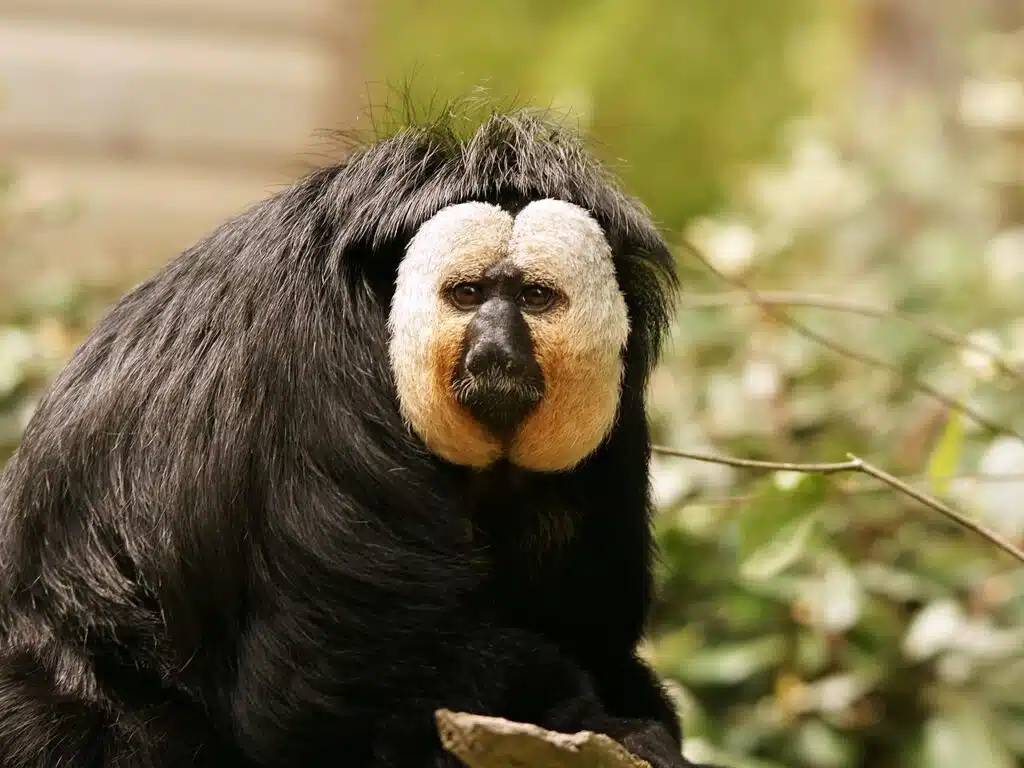
Male White-faced Sakis (Pithecia pithecia) have whiter faces compared to females with the rest of the fur being black.
This contrasting appearance is seen in males throughout their lives while females have gray fur and bright gray faces.
These types of monkeys are specific to regions of South America, where they spend their lives high up on trees.
Monkeys of this species may live up to 14 years in the wilderness and even more in captivity.
Much of their lives are spent in pairs within a group. Unlike other monkeys, White-faced Sakis form long-lasting male-female relationships. They breed together for life.
Also known for their strong teeth, these monkeys can eat an array of nuts and seeds. They can crack the shell open with their elongated canines.
Other types of food, including birds and animals are considered by the monkeys, at times.
For example, they may even eat bats venturing into the tree canopy.
Living in groups, they also tend to face predators in groups. Troop vocalizations are a common response to a perceived threat they try to intimidate.
Jaguars are among the predators most successful in capturing these monkeys.
3. Colombian White-faced Capuchin

With a range expanding from Colombia to Panama, these white-faced monkeys (Cebus capucinus) have a common pink and white face similar to The Central American White-Faced Capuchin.
The bright face of the species and the bright upper body also inspire their name the White-Throated Capuchins.
This is a small species with a versatile tail used for climbing and one of the most impressive intellects in the world of monkeys.
One example of their intellect is their capacity to use herbal medicine. They choose the leaves and plants with the most healing properties to rub against their body when facing different conditions.
These monkeys also understand the role of weapons and objects that can turn weapons when keeping predators away.
A species living in the upper canopy, The Colombian White-faced Capuchin is a species that also comes down for food frequently.
As they grow, these monkeys reach a size between 13 and 17 inches.
Much of their diet is based on fruit during all stages of their lives. Almost 100 species of fruit and insects make up their diet.
Figs are among their favorites, as with other species of monkeys.
As an intelligent species, these monkeys learn to distinguish ripe from unripe fruit and only choose the sweet fruit to pick when ripe.
4. Geoffroy’s Tufted-ear Marmoset
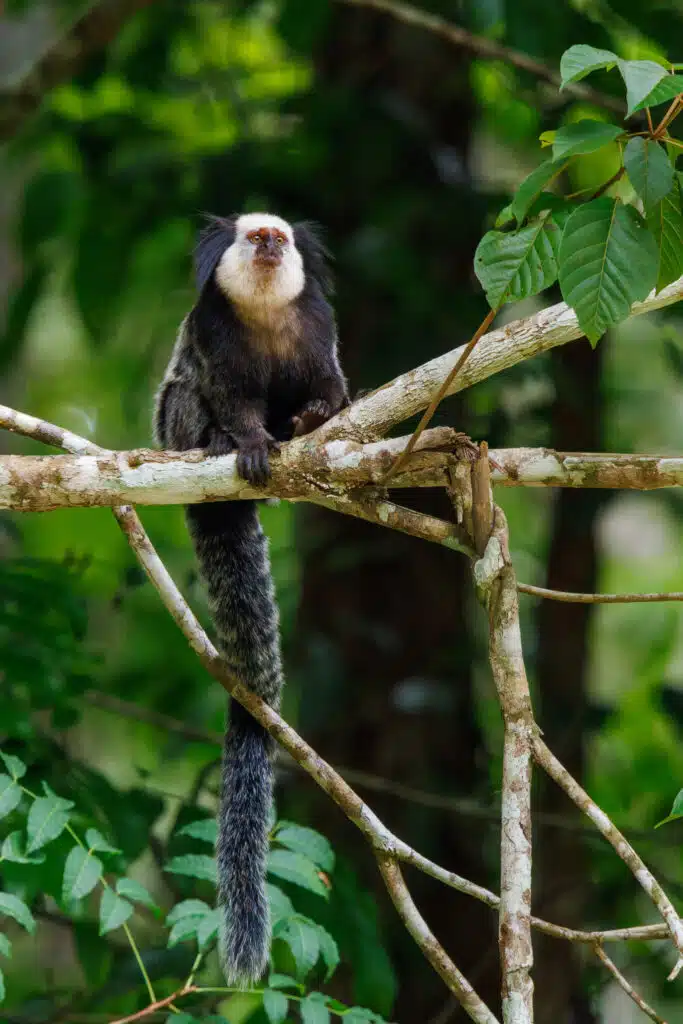
White faces are seen on both male and female Geoffroy’s Tufted-ear Marmosets (Callithrix geoffroyi).
These monkeys have dark brown and black fur with their white faces adding contrast to their appearance.
Small group living is characteristic of the species which shows the tendency to live in troops of up to 10 individuals.
While males and females are both part of the group, there’s a dominant pair that gets to breed.
The dominant female stops other females from breeding, mainly through a process of pheromone release.
Among all the different types of monkeys with white faces, Geoffroy’s Tufted-ear Marmosets have a short lifespan.
They only live up to 10 years in the wilderness and a bit more in captivity.
Most of their dietary choices are based on fruit. Secondary choices include insects and plant nectar.
The role of these monkeys is also as food in the ecosystem.
By some estimates, they are the monkeys with the highest number of predators such as raptors in the canopy and snakes both in trees and on the ground.
While they use different vocalizations to signal a potential threat, these monkeys are often prey to felines.
In the period of high predator activity, they can even alter their usual routines to more monitoring-focused routines.
5. Marañón White-fronted Capuchin
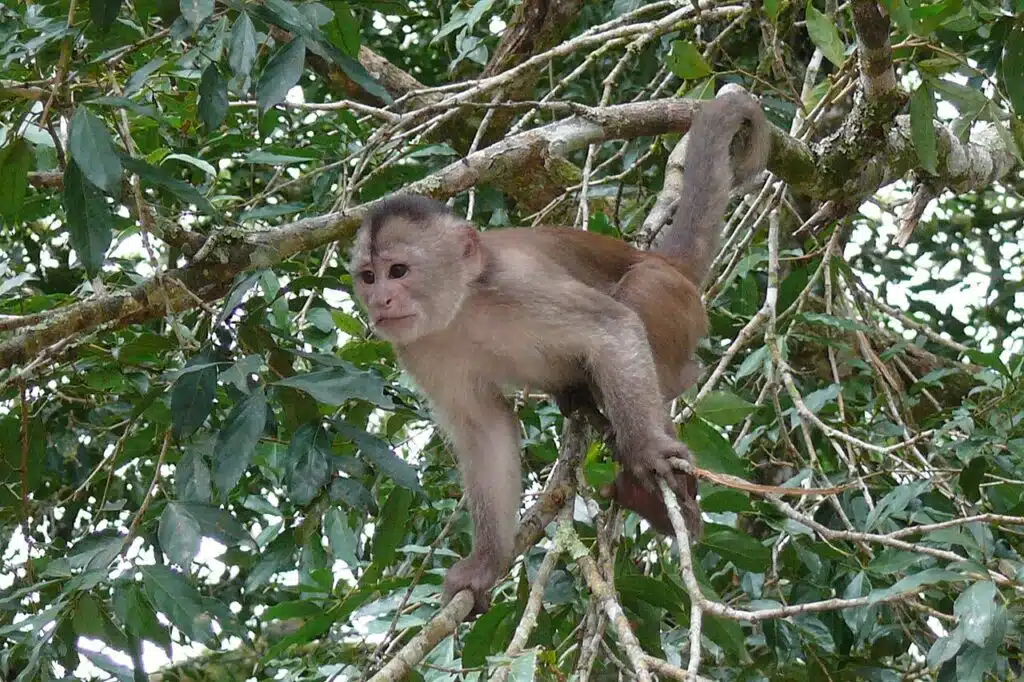
A species with bright face hairs and bald face patches, this monkey (Cebus yuracus) has a bright appearance specific to the head and upper body.
Gray to white hairs dominate its upper appearance while hairs on the lower part of its body are mostly brown.
Its presence is confirmed in The Amazon Rainforests. Due to the size of this rainforest, it’s not a species present through all of its premises, but rather in the Upper Amazon Basin.
Its cross-country presence is specific to Western Brazil, Southern Colombia, East Ecuador, and Northern Peru in disjunct populations.
As types of capuchins, these monkeys are also small and agile. Their reduced size even helps them feed upside down.
Mostly arboreal, the monkey is also partly terrestrial, even more compared to other Amazon monkeys.
The exact status of the species hasn’t been recently assessed but the last data on the species show this is one of the capuchins that are nearly extinct.
6. Santa Marta White-fronted Capuchin
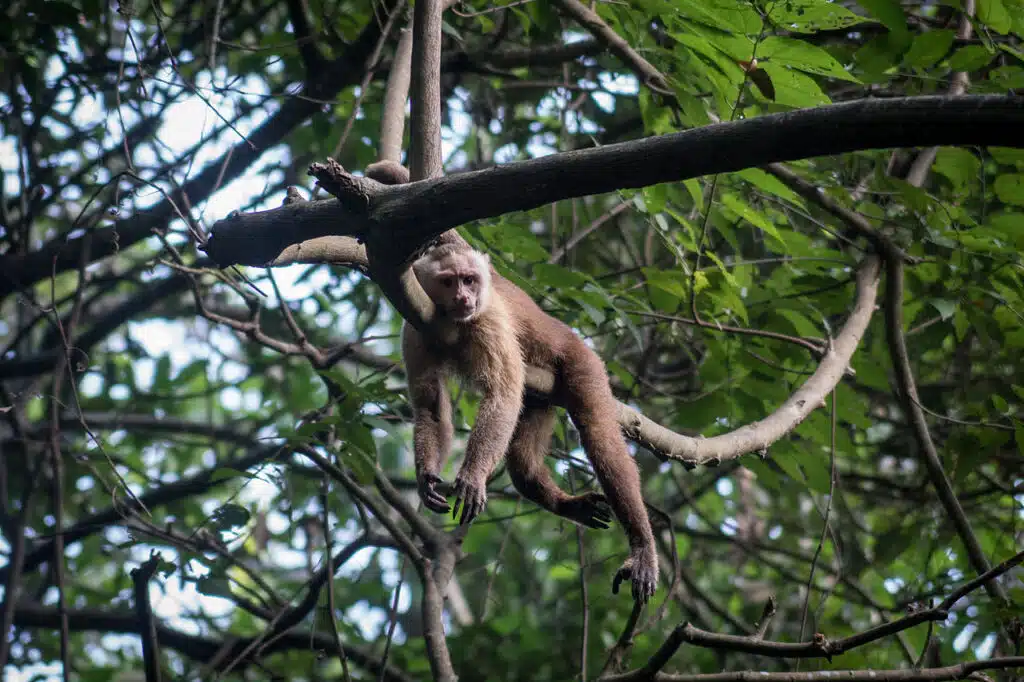
This type of capuchin monkey (Cebus malitiosus) is only found along the Sierra Nevada de Santa Marta in Colombia.
It shows a hairless pink face contoured by white hairs and a matching white upper body with brown hairs across the rest of its body.
Monkeys of the species are arboreal but they don’t escape a high number of predators such as felines and snakes.
A local species of wild cat, the margay, is known as its most agile predator.
These types of monkeys live in small groups of both males and females.
Aggression levels within the same group are low and even males of a troop tend to get along.
Males and females breed among them and may help out raising the offspring.
Even males tend to play with the young monkeys of the group and they may teach them their most common vocalizations.
Different calls are specific for different threats or actions. These monkeys even have a whistling sound specific to when they want to alert others the young ones are fighting among them.
7. Ecuadorian White-fronted Capuchin

Living in small groups, Ecuadorian White-fronted Capuchins (Cebus aequatorialis) are spotted in troops of up to 20.
These monkeys have bright faces and bright gray nuances dominating their appearance with a black cap, similar to other white-faced capuchins.
Studies on these monkeys aren’t very conclusive when it comes to their exact habits due to their low numbers, which are slowly increasing.
These types of monkeys are believed to suffer from human intervention in their habitat in the form of industrialization.
Possible damages made to crops also mean these types of monkeys are also hunting targets as they may be seen as invasive.
As with other monkeys of these sizes, fruit tends to attract them the most. They can invade local plantations for food, where they become targets for farmers.
A species of the tropical dry forests in Western Ecuador, this species faces a fragmented habitat and loss of habitat which endangers its future.
8. Spix’s White-fronted Capuchin
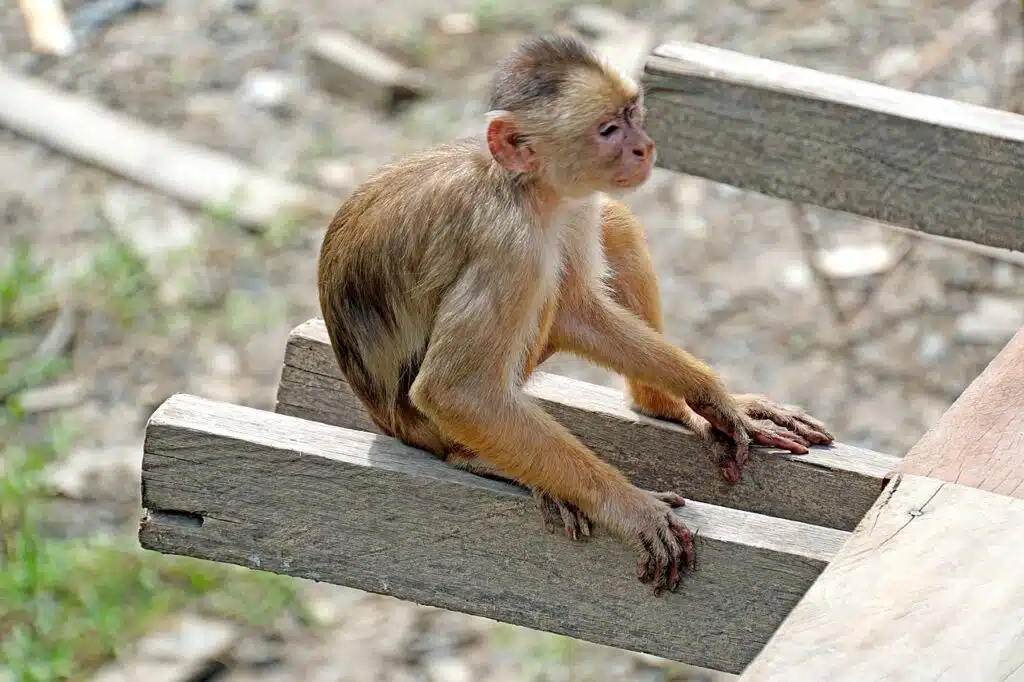
The small Spix’s White-fronted Capuchin (Cebus unicolor) is a species of The Amazon Rainforest.
It lives in The Upper Amazon in Brazil and Bolivia where it spends its days up on trees.
A pink-white nuance is specific to its face while the rest of its body is covered in brown hairs.
This is also a species of small monkeys, growing up to a size of 14 inches. Its numerous groups as well as its reduced size make it a target for local raptors.
Long considered a subspecies, this is a full species of white-faced capuchins with an orientation towards eating fruit.
Almost 100 types of fruit are consumed by them, together with other foods such as insects, invertebrates, and nectar.
Some of their tertiary food choices also include amphibians they can easily find on trees. as they rarely come down.
A typical troop may count up to 25 males and females living under the hierarchic rule of a male and female.
9. White-fronted Capuchin
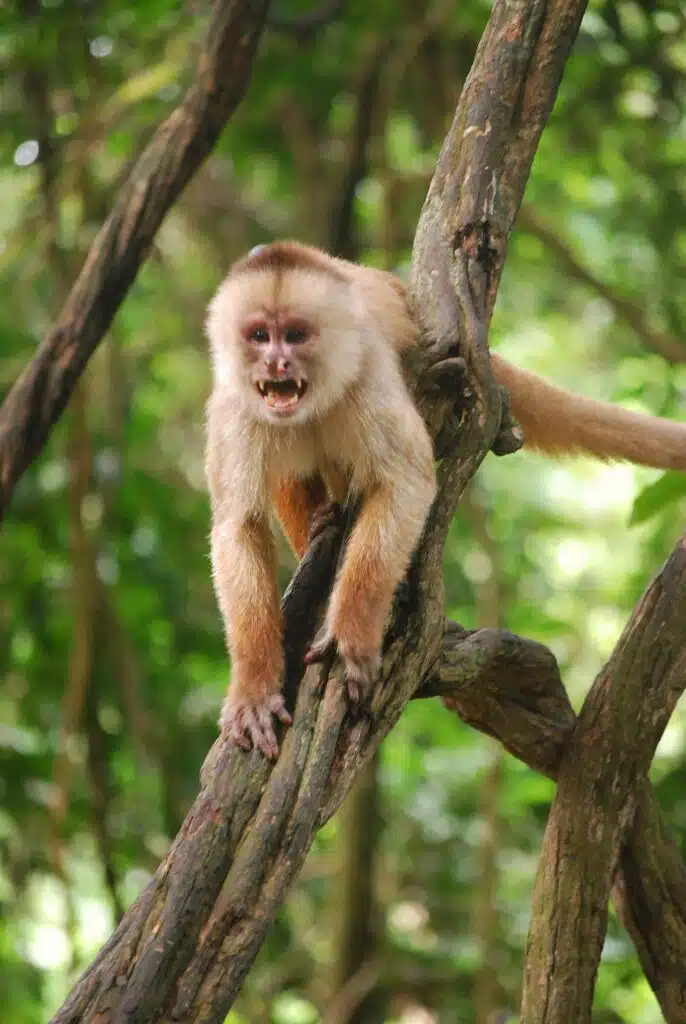
The White-fronted Capuchin (Cebus albifrons) is one of the most widespread white-faced capuchins in South America.
It can be found in the forests of Brazil, Venezuela, Colombia, Ecuador, and Peru.
A combination of arboreal and terrestrial living is specific to these monkeys.
They show the capacity to pick fruit from trees as well as look for seeds, eggs, and birds both on trees and on the ground.
This species is organized in groups but it fails to show a specific aggression to monkeys living in clear hierarchic structures.
White-fronted Capuchins are among the species that live in harmony, with alpha males enjoying a good relationship with all members of the group.
Some exceptions apply, specifically when a group intersects another group.
Like other white-faced monkeys, White-fronted Capuchins feed on fruit and invertebrates.
They are omnivores and may also consume frogs, birds, and their eggs, grasshoppers, caterpillars, or wasps.
10. Trinidad White-fronted Capuchin
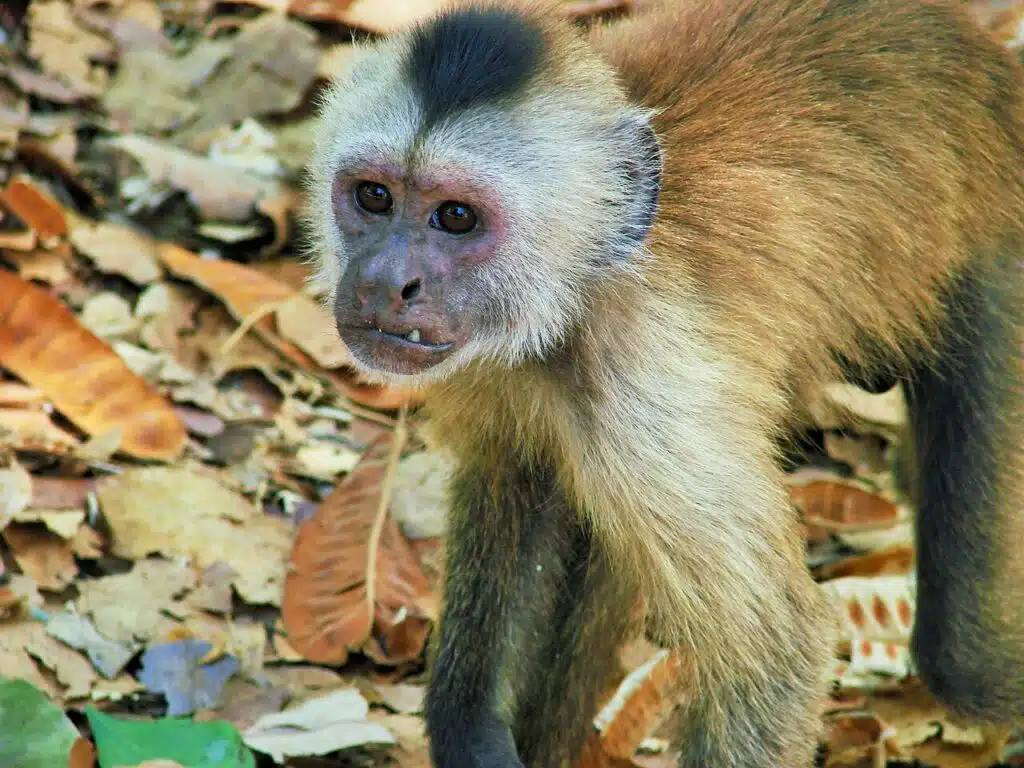
One of the rarest and most endangered types of white-faced monkeys lives in Trinidad.
The Trinidad White-fronted Capuchin (Cebus trinitatis) survives in low thousands among the few forests on the island.
Unlike a few other White-fronted Capuchins, this monkey has a matching white face and white hairs all across its body.
These monkeys live up in the canopy and they eat fruit either picked up directly from trees or on the ground.
Social living is specific to the species that live in mostly female troops with a dominant male.
The ties within the group are always strong. The monkeys like interacting with each other and that’s why no Trinidad White-fronted Capuchin can live on its own.
11. Rio Cesar White-fronted Capuchin

A white face, a white head, and a mostly white body are specific to the Rio Cesar White-fronted Capuchin (Cebus cesarae).
This is a species that only lives in the Rio Cesar Valley in forests close to water.
A small species of monkeys, they can grow to an adult size between 12 and 16 inches with a tail often longer than the body itself.
Living in groups of up to 35 individuals, these monkeys are highly social and work together to prevent them from falling prey to local predators.
These groups are dominated by an alpha male and by a hierarchic female.
Typical ‘ua’ vocalizations are among the first types of noises they make when spotting a predator nearby.
As a diurnal species, they spend time up on trees with occasional climb-downs for food. At night, they remain up on trees further away from possible predators.